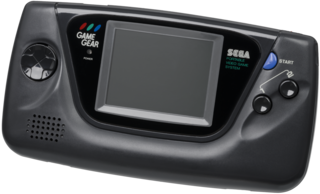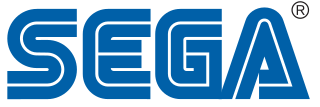Related Research Articles

The Game Gear is an 8-bit fourth generation handheld game console released by Sega on October 6, 1990, in Japan, in April 1991 throughout North America and Europe, and during 1992 in Australia. The Game Gear primarily competed with Nintendo's Game Boy, the Atari Lynx, and NEC's TurboExpress. It shares much of its hardware with the Master System, and can play Master System games through the use of an adapter. Sega positioned the Game Gear, which had a full-color backlit screen with a landscape format, as a technologically superior handheld to the Game Boy.

The Master System is an 8-bit third-generation home video game console manufactured and developed by Sega. It was originally a remodeled export version of the Sega Mark III, the third iteration of the SG-1000 series of consoles, which was released in Japan in 1985 with graphical capabilities over its predecessors. The Master System launched in North America in 1986, followed by Europe in 1987, and then in Brazil and Korea in 1989. A Japanese version of the Master System was also launched in 1987, which features a few enhancements over the export models : a built-in FM audio chip, a rapid-fire switch, and a dedicated port for the 3D glasses. The Master System II, a cheaper model, was released in 1990 in North America, Australasia and Europe.

The SG-1000 is a home video game console manufactured by Sega. It was Sega's first entry into the home video game hardware business. Developed in response to a downturn in arcades starting in 1982, the SG-1000 was created on the advice of Hayao Nakayama, president of Sega's Japanese arm, and was released on July 15, 1983, the same day that Nintendo released the Family Computer in Japan. It also saw limited release in Australia and New Zealand.

Gulf and Western Industries, Inc. was an American conglomerate. The company originally focused on manufacturing and resource extraction, but it began purchasing a number of entertainment companies beginning in 1966 and continuing through the 1970s. Most notable among the acquisitions were film studio Paramount Pictures in 1966, television studio Desilu Productions in 1967, arcade and later videogame manufacturer Sega in 1969, book publisher Simon & Schuster in 1975, and a number of music labels including Dot Records. Some of these properties were reorganized under the Paramount brand, with Dot Records becoming the nuclei of Paramount Records and Desilu becoming Paramount Television.

Namco Limited was a Japanese multinational video game and entertainment company, headquartered in Ōta, Tokyo. It held several international branches, including Namco America in Santa Clara, California, Namco Europe in London, Namco Taiwan in Kaohsiung, and Shanghai Namco in mainland China.

Sega Sammy Holdings Inc. is a Japanese global conglomerate formed from the merger of Sega and Sammy Corporation in 2004. Both companies are involved in the amusement industry.

Charles George Bluhdorn was an Austrian-born American industrialist. He built his fortune in auto parts and commodities such as zinc, and later through acquisition became CEO, chairman, and president of the Hollywood movie studio Paramount Pictures in 1966. Paramount was a former subsidiary of Gulf+Western Industries, which Bluhdorn purchased in 1956 when it was called the Michigan Plating and Stamping Company.

Hang-On is an arcade racing game released by Sega in 1985 and later ported to the Master System. In the game, the player controls a motorcycle against time and other computer-controlled bikes. It was one of the first arcade games to use 16-bit graphics and uses the Super Scaler arcade system board, created with design input from Yu Suzuki, as technology to simulate 3D effects. The deluxe cabinet version also introduced a motion-controlled arcade cabinet, where the player's body movement on a large motorbike-shaped cabinet corresponds with the player character's movements on screen.
Gremlin Industries was an American arcade game manufacturer active from 1970 to 1983, based in San Diego, California. Following its acquisition by Sega in 1978, the company was known as Gremlin/Sega or Sega/Gremlin. Among Sega/Gremlin's most notable games are Blockade and Head On, as well as being the North American distributors for Frogger and Zaxxon. The company's name was subsequently changed to Sega Electronics in 1982, before its operations were closed in 1983.
Shoichiro Irimajiri and raised in Kobe is a Japanese engineer and businessman.

Monaco GP is an arcade racing game released by Sega in November 1979 in Japan, and January 1980 worldwide. An upgraded version, Pro Monaco GP, was released later in 1980. One of the last Sega games to use TTL chips instead of a microprocessor CPU, the game has players race against a clock and pass rival racers while attempting to earn points driving through five areas.
Isao Okawa was a Japanese businessman and the former Chairman of Sega.

MagMax is an arcade video game which was developed by Nihon Bussan and released in 1985 under its brand Nichibutsu. A horizontal scrolling shooter, players control the title hover ship in an attempt to completely construct the ship into a giant robot and to destroy any enemies attempting to stop it.

Road Race is a 1976 car driving arcade racing video game developed and released by Sega in February 1976. Later the same year, Sega released two motorbike racing variants, Man T.T. and Moto-Cross, which were in turn re-branded as Fonz, in November 1976. The game was based on the character Fonzie from the 1970s TV show Happy Days, with the slogan being "TV's hottest name, Your hottest game". Sega licensed Fonz because at the time it was owned by Charles Bluhdorn's Gulf+Western Company and it was a Paramount Television intellectual property.
Hayao Nakayama is a Japanese businessman and was the former President and CEO of Sega Enterprises, Ltd from 1983 to 1999.

Sega Corporation is a Japanese multinational video game and entertainment company headquartered in Shinagawa, Tokyo. Its international branches, Sega of America and Sega Europe, are headquartered in Irvine, California, and London. Its division for the development of both arcade games and home video games, Sega Games, has existed in its current state since 2020; from 2015 to that point, the two had made up separate entities known as Sega Games and Sega Interactive Co., Ltd. Sega is a subsidiary of Sega Sammy Holdings. From 1983 until 2001, Sega had also developed video game consoles.
Nihon Bussan Co. Ltd. was a Japanese video game developer and publisher headquartered in Kita, Osaka. In the past they had also manufactured and sold yachts.

Periscope is an electro-mechanical arcade shooting submarine simulator. Two companies developed similar games with the name. The first, initially called Torpedo Launcher, was designed by Nakamura Manufacturing Co. and released in Japan in 1965, as the first arcade game Masaya Nakamura built. Sega Enterprises, Ltd. also built and released Periscope in Japan in 1966, as one of its first produced arcade games.

Console Wars: Sega, Nintendo, and the Battle That Defined a Generation is a 2014 non-fiction novel written by Blake J. Harris. It follows businessman Tom Kalinske in his venture as CEO of video game company Sega of America from 1990 to 1996, and details the history of the fierce business competition between Sega and Nintendo throughout the 1990s as well as the internal conflicts that took place between Sega of America and its Japanese parent company, Sega Enterprise. Harris wrote the book in the style of a novel by compiling several interviews with people who were involved with the events, using the information gathered to create a dramatic interpretation of the events. A documentary of the book directed by Harris and Jonah Tulis was released on CBS All Access on September 23, 2020. A miniseries adaptation is in development with Seth Rogen and Evan Goldberg executive producing with Jordan Vogt-Roberts directing.

The history of Sega, a Japanese multinational video game and entertainment company, has roots tracing back to Standard Games in 1940 and Service Games of Japan in the 1950s. The formation of the company known today as Sega is traced back to the founding of Nihon Goraku Bussan, which became known as Sega Enterprises, Ltd. following the acquisition of Rosen Enterprises in 1965. Originally an importer of coin-operated arcade games to Japan and manufacturer of slot machines and jukeboxes, Sega began developing its own arcade games in 1966 with Periscope, which became a surprise success and led to more arcade machine development. In 1969, Gulf and Western Industries bought Sega, which continued its arcade game business through the 1970s.
References
- ↑ "Sega Races With 'Fonz' Game" (PDF). Cash Box . December 4, 1976. p. 41.
- ↑ Pollack, Andrew (July 4, 1993). "Sega Takes Aim at Disney's World (Published 1993)". The New York Times– via NYTimes.com.
- ↑ Lipson, Ashley S.; Robert D. Brain (2009). Computer and Video Game Law: Cases and Materials. Carolina Academic Press. p. 7. ISBN 9781594604881.
- ↑ "The Next Level: Sega's Plans for World Domination". Wired– via www.wired.com.
- ↑ "Did You Know that Sega Was Started by an American?". Next Generation . No. 24. Imagine Media. December 1996. pp. 6–10.
- ↑ "The Meteoric Rise and Fall of Sega" (PDF). Archived from the original (PDF) on 2012-08-21. Retrieved 2012-04-26.
- ↑ "Periscope". Sega Retro. November 21, 2020.
- ↑ Who's who in California. Who's Who Historical Society. December 21, 1981. ISBN 9780960316625 – via Google Books.